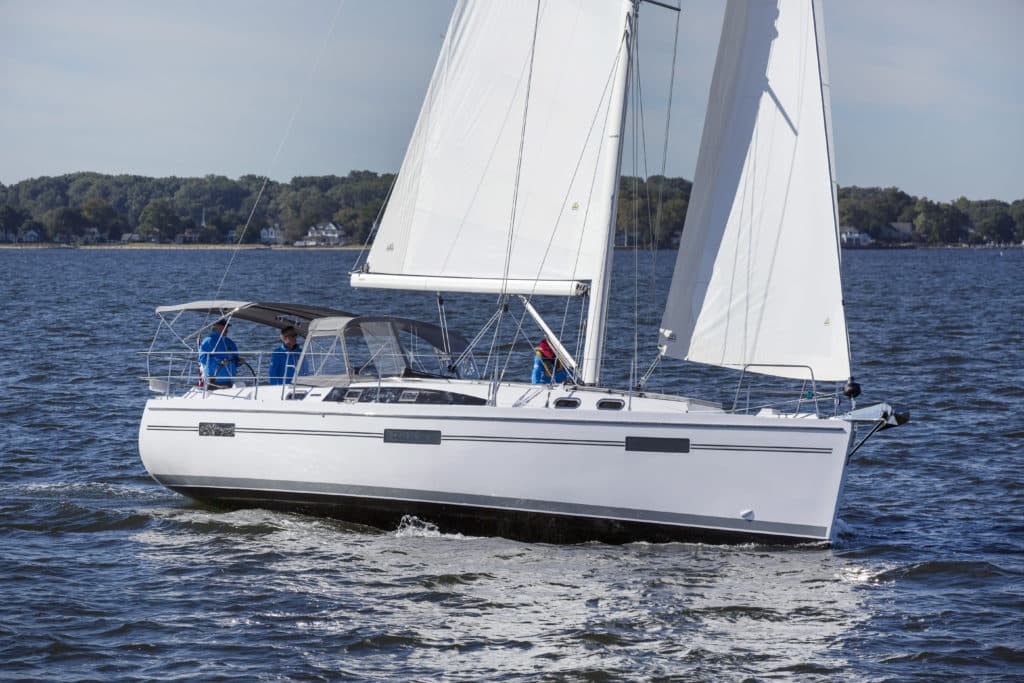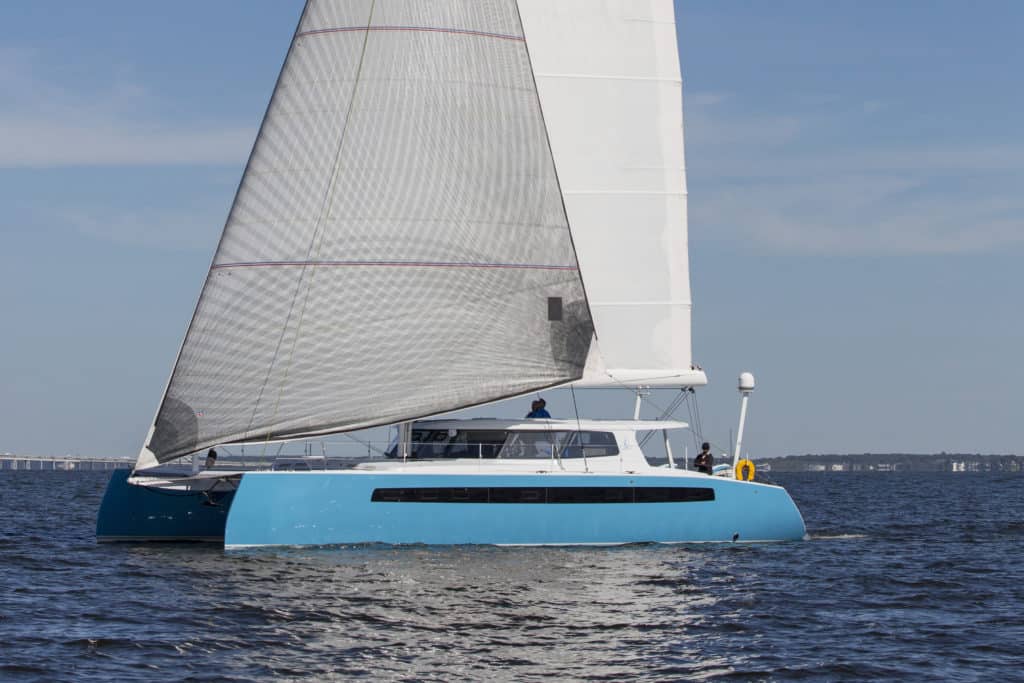Domestic Boat of the Year: Catalina 425

Not every naval architect gets the chance to take a second swing at a popular design a couple of decades after the splash of the original. But that is precisely the opportunity that presented itself to Catalina Yachts designer Gerry Douglas with his Catalina 425. The company’s original 42-footer debuted 23 years ago, and before all was said and done, Catalina produced more than 1,000 units of the highly successful production boat. Now Douglas has taken all he learned in the intervening years and amalgamated that knowledge in the new 425. And he knocked it out of the park. That’s why we’ve awarded the 2017 Domestic Boat of the Year award to the Catalina 425.
“With his history with the previous 42-footer, and the fact that he owned one himself, Douglas had an amazing feedback loop when he tackled the 425,” said judge Tim Murphy. “So he had a great list of things he wanted to change along the way, and boy, I felt this wasn’t like you were aboard a production boat, frankly. It has a very warm-feeling interior, and the fit and finish was emphatically good. With detail after detail, there’s a lot of value in this boat, which comes in at $315,000.”
“It had a higher level of finish than some of the more expensive boats in its category,” noted Ed Sherman. “One of the things Douglas said when discussing his personal design brief was that he wanted to have excellent service access to all the systems. He achieved that goal and did a nice job with it. Everything was easy to get to, labeled properly and quite good in that respect.
“It’s one of the few boats we sailed this year with a shaft drive, compared to saildrives,” he continued. “So it’s more of a traditional cruising boat in that respect. Overall, this is a great redesign. His old 42 had a center-mounted steering pedestal with an abnormally large steering wheel. Now he’s gone to twin wheels. It’s really opened up the cockpit nicely. Behind the scenes, the electrical panel, glasswork and so forth are all super clean.”
“Catalina did an excellent job with this boat,” said Carol Hasse. “There was a concerted focus on safety features. The target market is an experienced sailing couple in their 50s with plans for retirement cruising. This will be an excellent vehicle for that.
“I like the fact that all the lights were LEDs with dimmers,” she added. “It also has some cool, fun lights in the cockpit console that were kind of sweet. There was a beautiful saloon table, really awesome. The opening ports were good. The engine access was great. Overall, I was very impressed.”
So too were Hasse’s fellow panelists, which is why the Catalina 425 took home one of the two major awards for 2017.
Import Boat of the Year: Balance 526

It was a match made in multihull heaven. On the one hand, you had American Phil Berman, a world-class competitive Hobie sailor in his youth, who parlayed his knowledge, talent and passion into a decades-long career conceptualizing, sailing and selling cruising catamarans. On the other hand, you had designer Anton du Toit and the Paarman brothers, a trio of South African surfing legends who began their careers shaping and building surfboards and later applied that experience — along with their deep understanding of the wild waves, winds and currents that surge along the coast of their homeland — to the lamination, construction and marketing of long-range cruising cats.
The ensuing collaboration between Berman, du Toit, the Paarman bros and their company, Nexus Yachts, led to a balancing act in creating a light, fast cruising boat — one that two people could truly sail well — that nonetheless could carry a cruiser’s payload and offer complete, comfortable accommodations. The end result was the Balance 526, Cruising World’s Import Boat of the Year and Best Full-Size Multihull Over 50 Feet for 2017.
“Phil has entered other boats in the contest, including a Dolphin cat built in Brazil and an earlier Balance model built in China,” said Tim Murphy. “I think he’s nailed it with this one. In fact, I think the Balance 526 represents an important moment in the history of multihull design and evolution. We’ve been watching catamaran development for 20 years now. In the beginning, there were big, fat boats that at first weren’t designed for the loads that people put on them. But there was something missing in the marketplace that Phil recognized: a high-performance voyaging cat that an experienced couple could take anywhere. Then Gunboat came in with their 62-footer, a real thoroughbred boat, but it was more than most couples could handle; you needed a professional crew. Finally, we have that performance cruiser that a couple can actually sail well.
“The lamination work is very nice,” he continued. “This is a vacuum-bagged epoxy boat. A lot of the structure has carbon in it. It’s an E-glass boat for the most part, but where there are any high-load areas, they’re using carbon. So it’s a good, light structure.”
“The Balance we sailed had a high-end owner who decided to go full-on with a lithium-ion power plant, so we’re playing in the state-of-the-art arena here,” said Ed Sherman. “On the shore-power side, he was also very mindful of migrating around the world, so he set that up in such a way that he has a lot of options that are essentially switchable with the change of an adaptor. But there are also 1,200 watts’ worth of solar panels. To save weight, they went to a 24-volt DC system instead of 12 volts; this enables them to cut their wire gauge and such in half, which on a boat like this can add up to a lot of weight in just copper. It speaks to the whole concept of the boat.”
“The delivery crew that had brought the boat from South Africa were so enthusiastic about how the boat sailed and how functional it was,” said Carol Hasse. “They were sailors, like us, and they were all in sync with the boat in neat ways that made us all feel like ‘OK, this thing is totally happening. It’s well designed and seaworthy.’” Indeed it was. And it was also a big winner.








